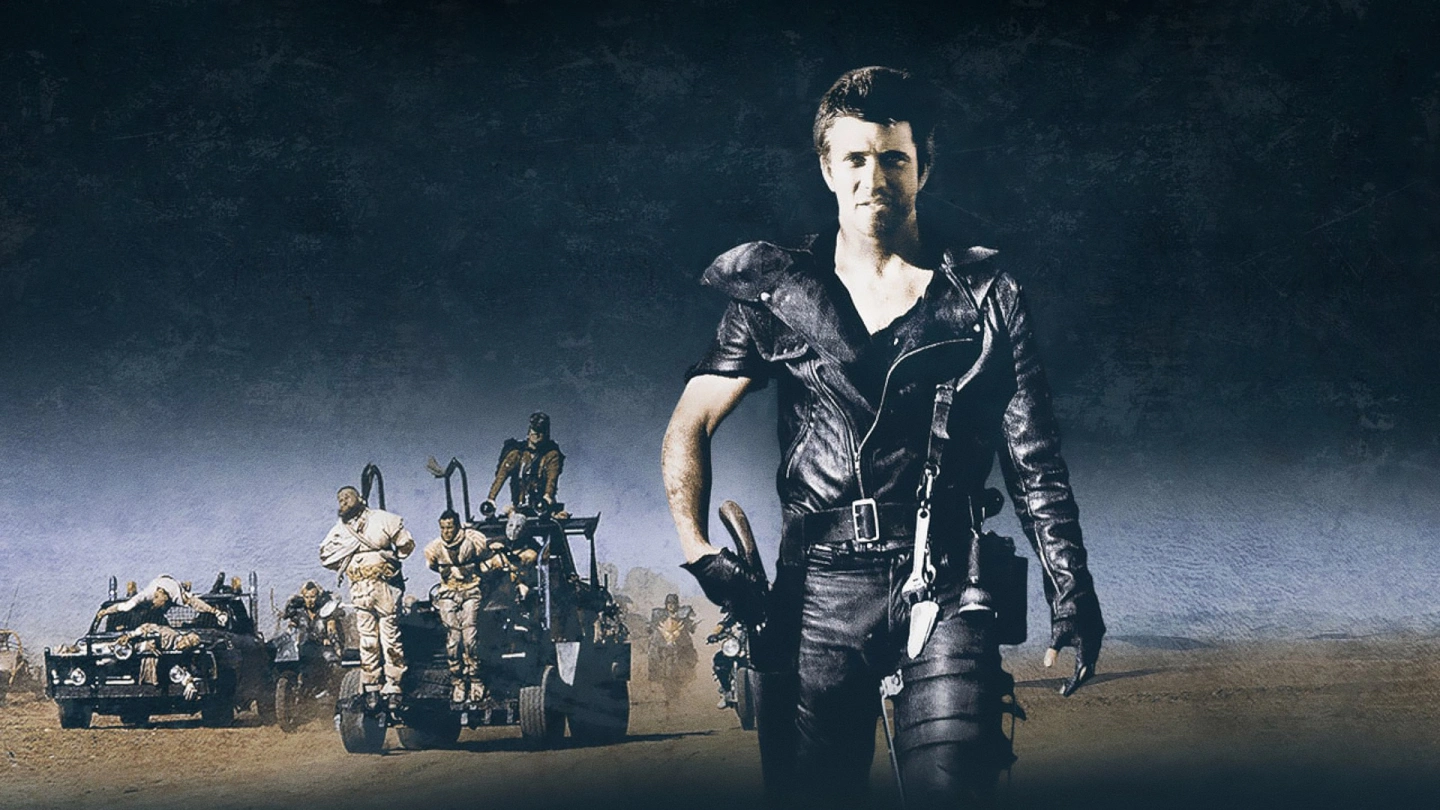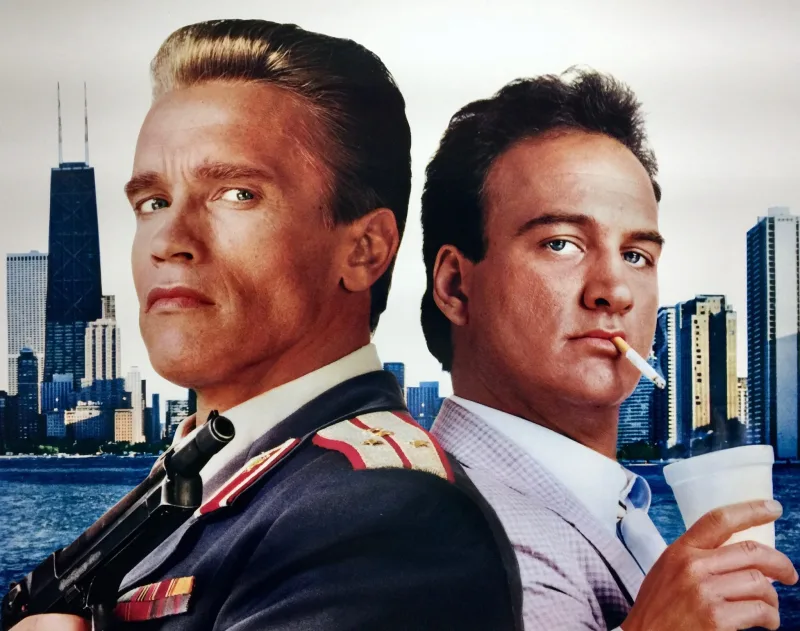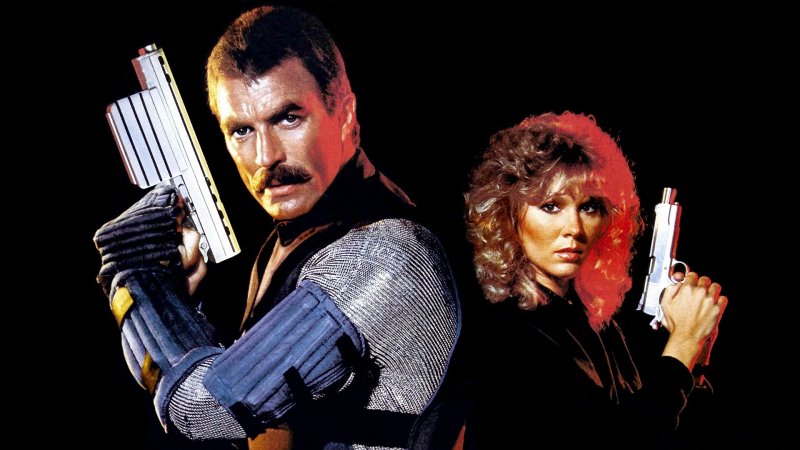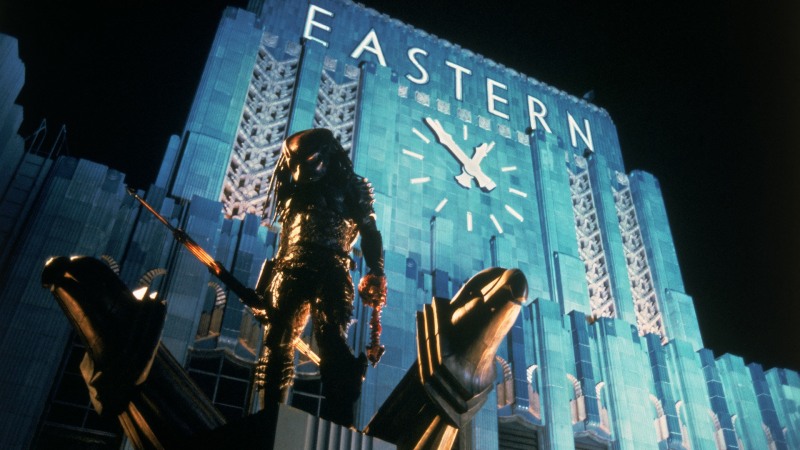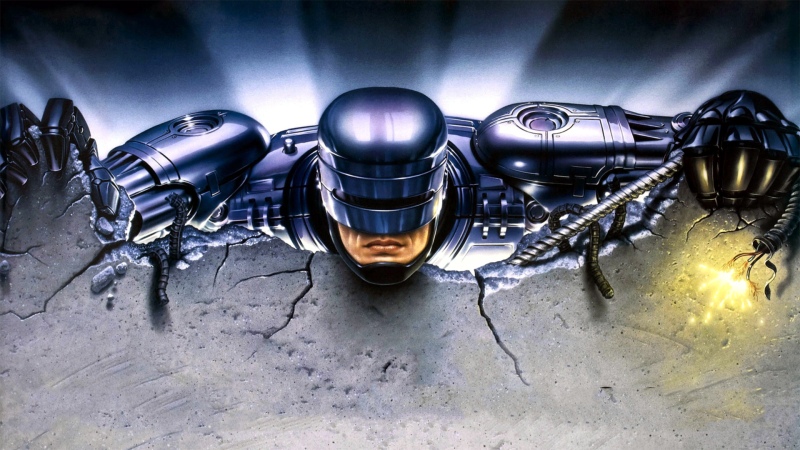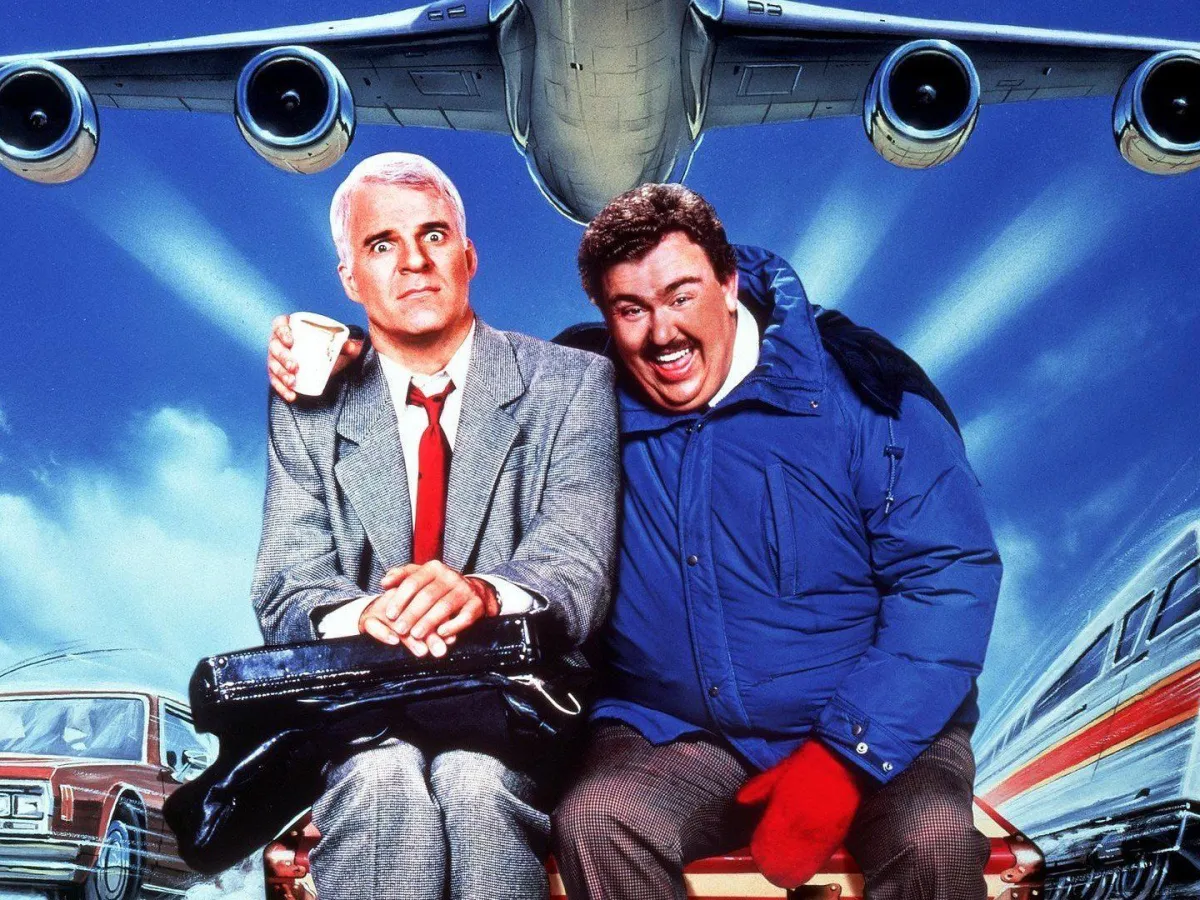
Meet Max, “the Road Warrior” Max, in George Miller’s hugely innovative action sequel
Not only is Mad Max 2 a perfect movie, it’s one of the most influential dystopian films ever made, becoming the standard bearer for not only action sequels, but action movies in general. You only have to look at what preceded it and what followed to understand its influence. Even today George Miller’s ravaged vision of society is prevalent throughout the sci-fi genre, particularly its innovative world building and costume design. There were countless toy ranges and video games based on Miller’s creation. There was even a hugely popular pro wrestling tag team named the Road Warriors who dressed and acted exactly like the movie’s twisted metal villains, their name of course lifted from the film’s alternate title The Road Warrior, a supremely cool moniker created for American audiences who weren’t familiar with the original movie’s limited release.
A slew of bargain-basement impostors crawled out of the nuclear dust in the wake of Mad Max 2‘s success, chiefly because, as proven by 1979’s hyper low-budget Mad Max, the concept could be done on the cheap. All you needed was a desolate landscape, a few broken-down vehicles and some rag-tag outfits and you could pass yourself off as one of the most imitated movies of its generation, of any generation, at least until someone yelled “Action!”
The film’s Ozploitation roots provided the perfect platform for Italian genre cinema, scuzzy efforts 1990: The Bronx Warriors (1982), Escape from the Bronx (1983), and The New Barbarians (1983) straight out of the Mad Max playbook. Aussie neighbours New Zealand gave us the rather familiar Battle Truck (1982), the title of which should tell you all you need to know about that particular movie. In the US, low-budget opportunists Charles Band and Golan-Globus jumped on the Mad Max bandwagon with movies such as Metal Storm: The Destruction of Jared-Syn (1983) and Jean-Claude Van Damme action vehicle Cyborg (1989). A young Patrick Swayze even tried Max on for size in 1987’s Steel Dawn, the same year Roddy Piper starred in the Miller-influenced, post-apocalyptic sci-fi comedy Hell Comes to Frogtown.

Mad Max wannabees weren’t restricted to the B-movie doldrums. Perhaps the most famous example of a Mad Max derivative happened to be the most expensive movie ever made back in 1995. Starring Kevin Costner as a Maxian loner who fit a very familiar profile, Waterworld was written off, somewhat unfairly, as Mad Max on water, thanks to a thinly veiled, like-for-like premise and a cast of characters who looked like they’d jet skied their way off the set of The Road Warrior. Box office returns of $264,000,000 were considered a huge disappointment for a movie that cost somewhere in the region of $175,000,000, killing the mainstream career of director Kevin Reynolds and plunging Oscar-winning megastar Costner into frosty commercial waters. It didn’t matter that the movie featured gorgeous aesthetics and hugely impressive action set-pieces. Cheap knock-offs were one thing, but a blockbuster Max clone was sacrilegious, the attempted mythology of Costner’s character looking like a cheap imitation despite the spectacle. Almost fifteen years after The Road Warrior‘s release, Max’s colossal shadow still loomed large.
The Road Warrior is one of those rare sequels that improves on its predecessor, an increased budget and Mel Gibson’s growing star power allowing Miller the chance to bring his money-spinning concept, and its characters, further to life. In true action sequel fashion, The Road Warrior is bigger, bolder and more violent, but it doesn’t jeopardise its integrity by succumbing to the many horrors of sequelitis. It doesn’t rely on past glories as much as it does enhance them, adding a skinny layer of meat to the pre-apocalyptic bones.
My life fades. The vision dims. All that remains are memories. I remember a time of chaos… ruined dreams… this wasted land. But most of all, I remember The Road Warrior. The man we called “Max.”
Narrator
I write skinny because, despite increased production opportunities and stylistic and technical advancements that are nothing short of muscular, Miller retained the narrative simplicity that made Mad Max such an exhilarating thrillride, focusing on the struggles of an oil outpost community under threat from a growing army of merciless outlaws. Mad Max, cited as the most profitable indie film ever made until 1999’s handheld smash The Blair Witch Project, would gross an incredible $100,000,000 worldwide on a budget of only 350,000–400,000 Australian Dollars, a paltry war chest that forced Miller into all kinds of questionable cost-cutting ventures. Miller would hire actual gang members to play biker extras (they were paid in cases of beer) and, much like the villains in his film, would even steal props from outside convenience stores like vultures in the night, or in their case the morning, returning them after vendors closed up for the day. It was a gruelling and hugely problematic production that left Miller feeling that he “wasn’t cut out for movies”, but for a film set on the ramshackle plains of a barren Aussie wasteland, such chaos only added to the rawness.

The Road Warrior was the movie Miller wanted to make back in 1979, and would have if it were not for such severe financial constraints. Film has long-since expanded on the pre and post-apocalyptic concepts, exploring every facet imaginable, but Mad Max excelled as a bare bones production that raised more questions than it answered, and to its credit. The best action movies thrive on stripped-down, full throttle mayhem, and the best speculative fiction is typically open to interpretation, allowing an audience to participate beyond a story’s duration. The Mad Max series excels in these areas. The original movie made you wonder how the world that Max inhabits, clinging to the last lingering threads of humanity, arrived where it did in such a short space of time, but like all great dystopia it doesn’t seem beyond the realms of plausibility. For a volatile species like mankind, the fall of civilisation is but a single catastrophe away.
Set “A few years from now…”, Mad Max depicts a society plunged into dissolution, one possible fallout from the real-life Australian oil crisis of 1979, which was a huge inspiration for both the movie and Miller himself. Max plays a cop from a threadbare precinct tasked with bringing down gangs of roving scavengers, lawless brutes who murder his wife and infant child in cold blood, transforming him from a loving family man into a ruthless purveyor of vengeance. The film ended abruptly too, asking further questions about what the future held for a man who had lost everything with only his iconic V8 Interceptor and miles of desolate and potentially hazardous roads ahead. What would become of a man who had undergone such a crude and seemingly irreversible transformation, especially faced with the prospect of such a bleak and unforgiving future?
“Every element in ‘Mad Max 2’ was worked out from the present, and from the premise that, suddenly, there would be no energy. No electricity. So, people would rush down to their supermarkets and take whatever was left in the refrigerators. They would find other people already there. There would be fights. We would have no gas for our vehicles,” Miller would explain. “Very quickly, things would reach a Darwinian stage where human beings would have to survive as best they could. Some would, undoubtedly, choose a brutal lifestyle, consuming whatever was left, since no more goods would be manufactured. But there would be pockets of people who would try to make a new beginning.“

The Road Warrior briefly expands on how we arrived at such a bleak and ravaged existence with a beautifully succinct prologue of footage culled from various real-life conflicts. It also gives us a deftly edited recap of the original movie’s “maelstrom of destruction”, reminding us of the lost person Max now represses and introducing us to the loner forged in his wake. It’s all so vivid, poetic and ahead of its time. Without going into specifics, it highlights the futility of mankind, that irrepressible urge for self-destruction, exactly the kind of pitiless environment that awaits us. It also sets up a movie that is much more cinematic, mythicising “the one they call Max”, a character who will become a figure of reverence against his wishes, who stands tall like a barely glimpsed monolith amid the chaos and destruction. The sequence emerges from the film’s bleak opening titles like a tumbleweed rolling majestically into battle, an indicator of what to expect from a filmmaker armed to the teeth with more than ten times the original movie’s budget.
The Road Warrior goes from strength to strength, jumping straight into what it does best, and arguably better than anyone else, before or since: the car chase. The opening onslaught proves but a teaser for the carnage that awaits. It also introduces us to wanderer Max’s newest nemesis, Wez, a wild-eyed killer with an even wilder Mohican garbed in assless chaps (yes, you heard me). The film’s costume design borrows heavily from the emerging S&M culture of the early 1980s, which was plenty controversial at the time, but these dudes aren’t in the mood for fun and festivities. They seem to have plenty of fun raping and pillaging, however, howling into the night like a pack of hyenas on the hunt for precious fuel (though, as one VHS Revival reader astutely pointed out, they sure are eager to waste it). Fuel is like goldust in Miller’s savage wasteland, civilisation but a flicker in the recesses of time.
Wez, played to the hilt by Commando‘s Veron Welles (he would later parody the role as an invading biker in the John Hughes teen comedy Weird Science), is second in command to “The Warrior of the Wasteland! The Ayatollah of Rock and Rolla! The Lord Humungous”. Humungous, a musclebound Jason Voorhees lookalike in a steel hockey mask with thick, ugly veins pulsating in his head, is straight out of a graphic novel, and his gang of half-baked hoodlums are no less of a visual grotesquery. Wez, who’s so out of control he has to be chained like a dog until the moment arises to unleash his unquenchable fury, is swiftly outmanoeuvred in the opening chase thanks to some slick driving from the newly stone-faced Max. The editing and direction are nothing short of prodigious.

It also helps to have future Academy Award winning cinematographer Dean Semler onboard (Dances With Wolves). Mad Max 2 was a crash course in on-the-fly filmmaking for Semler, Miller not one for in-depth storyboards, instead producing vague sketches of his vision hours before filming. Body’s would fly as a result of his rough-and-ready process, with multiple injuries incurred during filming, many of them rather severe. Broken bones, wilted spirits and accidental nuggets of glorious destruction were all part and parcel of Miller’s full-throttle production. If when watching The Road Warrior you suddenly cringe and tell yourself, “that had to have hurt”, it’s because it probably did.
What is it with you, huh? What are you looking for? C’mon, Max, everybody’s looking for something. You’re happy out there, are you? Eh? Wandering? One day blurring into another? You’re a scavenger, Max. You’re a maggot. Did you know that? You’re living off the corpse of the old world. Tell me your story, Max. C’mon. Tell me your story. What burned you out, huh? Kill one man too many? See too many people die? Lose some family?
Pappagallo
In The Road Warrior, Gibson’s Max gives new meaning to the ‘man with no name’. Of course, he has a name, one that he no longer has any use for as he aimlessly hunts for scraps, flat-out rejecting all hope of a new beginning for fear of repeating the past. The man-of-few-words ethos embraced by the likes of Clint Eastwood is central to the movie. Like the classic Samurai, the unknown solider or the high plains drifter, Max is steeped in mythology, an enigma who refuses to acknowledge or reveal his own humanity. Like Snake Plissken, another classic antihero with more than a shade of the Max about him, he becomes the kind of unwilling hero who accepts the role simply because there’s no one else who can. Miller’s idea for the original Mad Max was to create a silent movie with sound, relying on unique aesthetics and the kind of stripped-down story that didn’t necessarily rely on dialogue to move the plot forward. In The Road Warrior, Max hardly utters a word.
Gibson was one of the industry’s few heartthrobs who could play a believable bad ass. His incredible transformation from blue-eyed babyface to grizzled drifter, an emotional apparition motivated entirely by personal survival, is utterly astonishing, and seriously iconic. When we first meet The Road Warrior‘s Max, accompanied by an equally grizzled companion known simply as “Dog”, a faithful blue-heeler who takes the phrase ‘man’s best friend’ to literal extremes, he has succumbed to a life of monotonous self-preservation. He’s essentially no different from the other scavengers polluting the earth save for the fact that he seems to derive no joy from his actions. Max, like his instincts, is on autopilot: ceaseless, unflappable and almost devoid of emotional variation. In his mind, solitude is not only the best way for survival, it’s the only way.

When Max is taken to the oil outpost by Bruce Spence’s gloriously spineless The Gyro Captain, another parasite who offers our protagonist endless fuel after an ambush gone awry, Max assesses the situation. Nearby, a raucous gang of outlaws bide their time, awaiting the perfect opportunity to pounce. Sooner or later, their prey will be forced to leave their figurative rabbit hole, and the vultures are forever circling. When Max witnesses residents of the outpost hunted down and killed, he sees only opportunity, agreeing to rescue a survivor in return for as much fuel as he can carry, but when that survivor dies so does their deal, and loner Max is exactly where he doesn’t want to be. Not only does he become prey like the rest of them, he’s the reluctant member of a society who thrive on unity and togetherness, who possess all the human qualities that he’s learned to resist.
There are stirrings of the old Max, mainly through his relationship with the ‘Feral Kid’, a seemingly parentless preteen who swings like a simian and scurries through underground tunnels like a prairie dog, unflinchingly burying a steel boomerang in the head of Wez’s muse in defiance of the gang’s attempted coup. There’s still an ember of the child left in the Feral Kid, one that escapes in grunts of wonderment thanks to an old wind-up music box that Max tosses to him, the last artefact of his perished humanity. From thereon the two are kindred spirits in the youngster’s mind, but Max is resilient, even when the kid attempts to stow away in his Interceptor after Max rejects communal life for fuel and the open road, a decision that almost costs him his life. That’s about as much as you get in terms of tenderness. There’s hardly a whiff of a love interest; there are only killers and survivors, the lucky and the unfortunate. Even Max’s trusty pooch meets his maker in a typically blunt fashion, and how often does the barking companion get it? If you’re in need of cheering up, the mutt in question was actually a rescue dog cast in the film on the eve of being put to sleep. Sometimes reality is more forgiving than fiction.
The Road Warrior is more ambitious than Mad Max in both scope and presentation. It still presents us with a scant civilisation built from scrap metal, a people forged from the dogged leftovers, but it possesses a grandeur absent from its more humble predecessor. Everything is bolder, more spectacular. It has the epic feel of an adventure movie, utilising the kind of Kurosawa transition wipes later popularised by the Star Wars series. But, crucially, it doesn’t do away with its exploitation lineage. Buoyed by Brian May’s colossal, doom-laden score, The Road Warrior is relentlessly bleak and incredibly violent, often treading horror territory with cringeworthy instances of bodily harm and gross-out jump scares that are genuinely unsettling. I’m not talking run-of-the-mill, ‘that’s so fake’ CGI moments, I mean deeply fallible instances of practical effects repulsion. Crushed bodies, chopped fingers, exploding heads; it’s absolutely startling at times. There’s even a moment when Wez returns for one last scare in true horror fashion, and thanks to the ceaseless action assaulting every last frame, you just don’t see it coming.

Incredibly, The Road Warrior still manages to squeeze in a little levity, mainly through Max’s reluctant partnership with Spence’s hugely endearing Gyro Captain. It all hinges on gallows humour, but the two have great chemistry. Naturally, Max treats his quasi-accomplice like dirt. He doesn’t trust anyone, and he certainly doesn’t seek the trust of others, but despite Max’s callousness the Gyro Captain seems determined to win him over. They may be little more than loose associates out for what they can get, but it’s the closest thing to a relationship you’re ever likely to find in such a parasitic, dog-eat-dog environment. After the Gyro Captain rescues a left-for-dead Max in a gorgeous overhead POV shot that wouldn’t look out of place in Apocalypse Now, ultimately following his ‘partner’ into battle, he, and we the viewer, finally get a smile out of the bloody and beaten Max, a crucial one for an audience who want to relate on a human level.
As for me, I grew to manhood, and in the fullness of time, I became the leader… the Chief of the Great Northern Tribe. And the Road Warrior? That was the last we ever saw of him. He lives now… only in my memories.
Narrator
The film’s final chase, a thirteen-minute whirlwind of beautifully orchestrated carnage, is still one of the finest action sequences in the history of cinema, and certainly my personal favourite. Due to constraints, sequences were pieced together during different times of the day, and if you look closely enough you’ll notice continuity inconsistencies, particularly at the beginning of the chase when we suddenly shift from dusk to dawn in a single frame. This may represent a flaw in the eyes of some, but for me it just adds to the bitches brew of fast forward effects, woozy Humungous monologues and all-out madness that lends the film such a heady aura of comic book fantasy. Miller was equally unconcerned, suggesting that with so much going on in every single shot no one would notice. Earlier, I claimed that Mad Max 2 was a perfect movie, and I stand by those words. Sometimes perfection is forged through imperfection.
The film’s final gauntlet of weapon-infused custom buggies, bikes and even a Tatra T815, a colossal truck commonly referred to as “The War Rig”, is the most exhilarating chase sequence I have personally ever witnessed. The action and violence are so creative, the pace so relentless, it’s like you’re surviving on a single breath for the entire thirteen minutes. It’s all so compellingly reckless too. Bodies are thrown under trucks, some smashed between vehicles, others ravaged with all kinds of deadly implements, and the stunts are mind-blowingly dangerous, a destruction derby that uses human bodies as bait. The moment in which one biker is sent somersaulting into oblivion after smashing into another vehicle leaves me gobsmacked every time I see it. They just don’t make movies like this anymore.

It astonishes me how Miller and his crew are able to maintain such high levels of tension given the difficulty of capturing such an expansive cast and piecing it all together. The editing team of David Stiven, Tim Wellburn and Michael Balson work miracles, but to even imagine such a bold and breathless sequence is a feat of pure genius. In this regard, Mad Max 2 is a work of art that has arguably never been matched, at least without the aid of CGI. Miller would make a point to retain the stunt work that made him famous for his glorious comeback in 2015’s Mad Max: Fury Road, a movie that would bag an Academy Award for Best Production Design. Miller claimed that ‘Fury Road’ was 90 percent practical effects, a decision that would result in arguably the greatest action movie this century, but as gorgeous and as furious as it all is, it doesn’t quite have that reckless edge. Not that I’d want anyone to go through the kind of risks that The Road Warrior subjected countless stuntmen too, but there’s something so dangerous about the film that will likely never be matched. It’s all so visceral. You can almost taste the blood.
When it comes to the big franchises, people will always sing the virtues of Star Wars, James Bond, Batman, and for good reason. Mad Max doesn’t quite have the breadth of those truly blockbuster franchises, but with upcoming prequel Furosia taking the series in a different direction, the possibilities are endless, and with Miller once again set to direct, co-write and produce, there’s little chance he’ll sell out and go Disney like Star Wars; all those elements that keep Max grounded: the violence, the stunts, the dark themes, will surely remain. The series has gone from Ozploitation to epic dystopia to action artistry on a truly monumental scale, and despite stumbling briefly into late-80s self-awareness with the still hugely enjoyable Mad Max: Beyond Thunderdome, it has managed to stay largely true to itself, and, with Miller at the helm, will no doubt continue to do so.
As for Max, the ‘Road Warrior’ Max, he stands toe-to-toe with the greatest antiheroes in modern cinema, and perhaps just a little taller than most. The fact that the film’s narrator turns out to be the ‘Feral Kid’ of some unseen future, now fully lingual and teeming with reverence, is a beautiful touch, giving us insights into Max that are, at least in a narrative sense, first hand rather than non-diegetic. Mel may have hung up the leathers long ago, the series may have already shifted focus from Miller’s original protagonist, but Gibson’s creation is a true icon, a demigod of cinema whose inimitable aura permeates modern culture to this very day. That version of Max, THE version of Max, lives now only in our memories. And long may he continue to do so.
Director: George Miller
Screenplay: Terry Hayes,
George Miller &
Brian Hannant
Music: Brian May
Cinematography: Dean Semler
Editing: David Stiven,
Tim Wellburn &
Michael Balson

